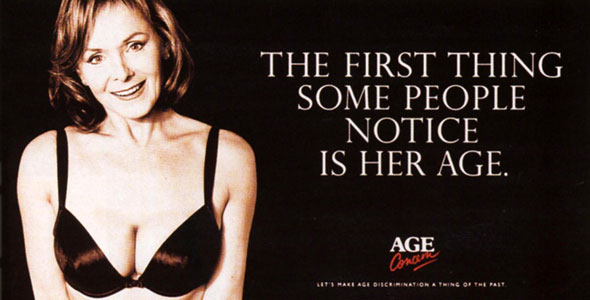
Last week I caught sight of an advert that aired on UK television. It featured a man who looked to be in his 20s walking arm in arm with a slightly older woman – dressed in leopard skin and with long blonde hair – towards the check-in desk of an airport. As they approached the stewardess, she asked the man: “You’re not going away with that old bag are you?”. The camera panned to the tattered suitcase on the floor and then to the couple who stood there looking stunned. The ad then faded out to the voiceover “Dump the old bag” (which happens to be its title). The ad can be viewed in full here.
For a few seconds I wondered if I’d fallen asleep and woken up in a bygone era. Thankfully the ad aired late evening, around 10.00 pm, which (hopefully) minimised its audience. And I haven’t seen it since.
I’m not sure why advertising companies use derogatory messages as a marketing ploy. But I don’t believe that it’s just a matter of being controversial, although controversy does attract attention. Perhaps it’s tongue-in-cheek, ignorance, or maybe complete disregard? Maybe it is downright prejudice. What do you think?
Social psychologists have pointed out that sexism and ageism are so entrenched in western society that we tend to take them for granted and simply do not notice them until we encounter the prejudice or discrimination ourselves. For example, we know that Western advertising has a long history of using sexist imagery and messages to sell products, but few of us are aware of the extent to which this operates. Take a look here for an insightful, consciousness raising, slideshow of the ways that advertisers use sexualised images of (young) women to sell various products.
The slideshow raises many important questions about gender, media and sexuality. One of the main points being that it is the cumulative effect of such messages that makes them so powerful. But I’m not going to explore those questions here. In this post I want to focus on advertising where sexism combines with ageism, producing a toxic mix for women and girls at all stages of the life-course.

Take this advertisement for a French paint company. It tells us that “Your walls deserve a paint that will age well”. Unlike women’s breasts of course. Sagging female breasts are equated here with aged bodies, thus ignoring other causes of loss of breast tissue such as weight loss or breastfeeding. The advertisers thought that producing an advert with a male equivalent would work too (perhaps they were trying to avoid accusations of sexism?):

Again, the image of the sagging chest and abdomen accompanies the strapline that our walls deserve a paint that ages well. The message we receive from the visual images and the accompanying text is clear: to have an older body is to have a deteriorating body, and an old body is not appealing to the eye. The older female body has been used in a similar way in the ad below where, again, the advertisers use the concept of ‘old bag’.

Clearly, older bodies, and the aged female body in particular, are not something we desire (as suggested in the paint ads) or will love (as the luggage ads tell us). Indeed, in these adverts an old body is comparable to an old piece of luggage; it is thus objectified. It is also disembodied (e.g. the advert above where just the torso is visible) in the same way that many sexualised shots of women are. I don’t know why they decided to present the woman in her underwear.
Take a look at this next ad:

The billboard poster above shows 56 year old Pearl Read reproducing one of the (now iconic) Wonderbra adverts of the 1990s. It was commissioned by Age Concern (Age UK) to challenge the ageist messages we receive through UK advertising. There was criticism of this campaign; mainly that it did not ‘do enough’ to address ‘societal obsession with appearance and perfection’. In my view, the ad makes you stop and think and thus has achieved what Age Concern intended.
Campaigns like this are important as they work to counter the ageism we see in some current day advertising. But they are in the minority.
This bothers me because advertisements that show images of ageing tend to reflect and reinforce social attitudes about getting old, including sexuality, and thus they can play a key role in shaping our expectations of what it means to be an older woman (or man). They raise questions about age prejudice in the societies which do not censor them. And while we may be bound by the values and ideas of the society within which we live, there are so many other ways of attracting attention to sell a product than by being controversial, offensive or out-and-out ageist.
Acknowledgements
Thanks to: Professor Lisa Wade for the sagging breast image; Raining Ads and Dogs for the sagging chest; and Unapologetically Female for the female torso luggage image.
- Comment
- Reblog
-
Subscribe
Subscribed
Already have a WordPress.com account? Log in now.



2 comments ›